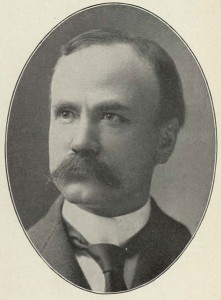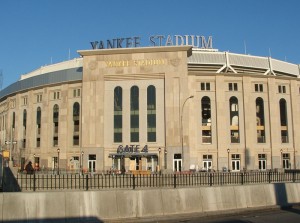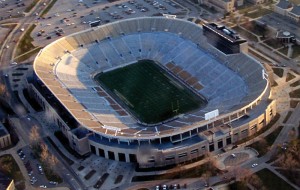Although mostly known as a world-class designer and builder of innovative steel bridges when he founded his consulting engineering firm in 1892, it was not long before Frank Chittenden Osborn (Figure 1) greatly expanded his practice to include the design of a wide array of structures, not the least of them being large-scale sports facilities. By the beginning of the 20th century, his company’s reputation for engineering such structures was so stellar that Osborn Engineering was known as “stadium designers for the nation.” One of the firm’s most conspicuous stadiums, nearing completion at the time of his death, was the original Yankee Stadium (Figure 2) in New York City, which debuted in 1922 and soon acquired the nickname, “the house that Ruth built.”
In addition to this New York icon, early Osborn-designed Major League Baseball stadiums included Forbes Field, Pittsburgh (1909); League Park, Cleveland (1910); Comiskey Park, Chicago (1910); Griffith-National Park, Washington, DC (1911); Fenway Park, Boston (1912); Tiger-Navin Field, Detroit (1912); and Braves Field, Boston (1915). Also engineered by Osborn’s group, with Henry Herts as architect, was the 1911 Polo Grounds in New York, the sixth concrete and steel stadium built for the Majors (and the second in the National League behind Forbes Field). In addition to being home to baseball’s New York Giants, the stadium’s large number of spectator-friendly outfield seats also made it well-suited for football games, including nine of the annual Army-Navy contests (Figure 3) between 1913 and 1927.
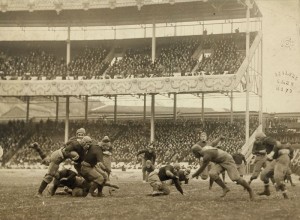
Figure 3: Army-Navy football game at Polo Grounds. Courtesy of Library of Congress Prints and Photographs ppmsca.19488.
In 2007, when Frank and his son Kenneth were both inducted into the exclusive Alumni Hall of Fame of Rensselaer Polytechnic Institute (RPI) at the same time, spokesperson Jeff Schanz said, “They were entrepreneurs, innovators, opportunity-recognizers, risk-takers and outstanding engineers. Their experience in structural steel and concrete enabled major cities and colleges alike to provide modern, safe stadiums for a new era of professional and collegiate athletics. They’re an inspiration to us all, and their legacy of excellence shines brightly on every Rensselaer student and alumnus.”
Born on December 18, 1857, in Maple Grove, Michigan, in the northwestern section of the state where it fronts Lake Superior, Frank was the middle son of Reuben and Livonia (Chittenden) Osborn. His father Reuben was senior physician for the Calumet and Hecla Mining Company and a prominent member of the Calumet, Michigan community, serving terms as town clerk and as treasurer – and also as a leading school official for thirty years. He was vice-president of the Merchants and Miners Bank of Calumet and director of Farmdale Land and Livestock Company. In the late 1870s, while his son Frank was in college at RPI in Troy, New York, Reuben served as an influential Michigan state senator.
Frank entered Rensselaer in September 1876 after graduating with high marks from Calumet High School. At RPI, he met and quickly befriended George Ferris (1859-1896), a bright, daring and self-assured 17-year-old from Carson City, Nevada. Although more than a year apart in age and raised in vastly different styles and parts of the country, Frank and George had much in common. For one, both were active in the Chi Phi fraternity and the Pi Eta Scientific Society. In fact, they were enthusiastic founders of Chi Phi at RPI, attracting a Theta chapter there in 1878. The Osborns, like the Ferrises, arrived in America in the early 1600s, and both families qualified as Sons and Daughters of the American Revolution blue bloods. Early in their careers, the two RPI graduates were found working for the same companies and living in the same cities. Later in their careers, both had thriving engineering businesses only 115 miles apart, Osborn in Cleveland and Ferris in Pittsburgh.
Immediately after receiving his civil engineering degree from RPI in the spring of 1880, Osborn entered the service of the Louisville Bridge and Iron Company in Louisville, Kentucky, as assistant engineer. Four months later and just before his marriage on October 27, 1880 to Annie Paull in Calumet, he was advanced to principal assistant engineer with more responsibilities. The Osborns would have two sons, the younger of whom died at birth. Their older son, Kenneth Howard Osborn (1886-1949), would follow in his father’s footsteps and study civil engineering at RPI. After graduating and working briefly for a couple of other engineering organizations, Kenneth joined his father in his flourishing consulting business. Before long, he would become heavily involved in the firm’s expanding stadium design practice and be responsible for many of its high-profile projects.
In 1885, a year before Kenneth was born, Osborn left Louisville Bridge and Iron to become principal assistant engineer with Keystone Bridge Company in Pittsburgh, Pennsylvania, a steel building company founded in 1865 by Andrew Carnegie, the world’s second-richest man. Two years later, in 1887, Osborn was working for and a principal in Ferris’s flourishing engineering firm, G. W. G. Ferris and Company, headquartered in Pittsburgh.
As a leading member of Ferris’s company, which specialized in the inspection and design of major structural steel works around the country, Osborn was mentor and role model to many of the newly hired young RPI-educated engineers employed by Ferris. Included was William Gronau (1866-1924), a fast-learning engineer who would one day be the lead analyst for the giant, history-making wheel Ferris would build for the 1893 Columbian Exposition in Chicago. Osborn trained young Gronau so well that when Osborn left the firm in 1889, Gronau took his place as the engineer “in charge of design of bridge work.”
Osborn left Ferris to become chief engineer for the King Bridge Company in Cleveland, one of the country’s most rapidly emerging large bridge builders. The King Company had just won the bid to build the Central Bridge over the Ohio River (Figure 4) near Cincinnati, Ohio, a Ferris Company-designed structure. One of Osborn’s first assignments with King was to complete the detailed shop drawings for the bridge, then supervise its construction. Once the project was completed, Osborn was ready to move on.
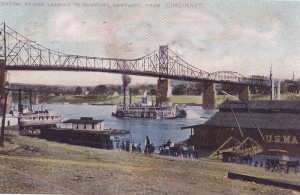
Figure 4: Postcard of Central Bridge, Ohio River at Cincinnati. Courtesy of Peggy W. Holiday Collection.
In 1892, 34-year-old Osborn founded Osborn Engineering Company based in Cleveland. Initially established to design and consult on all types of major structural steel projects, the firm quickly became experts in the use of reinforced concrete as a major construction element. With the nation sinking into the throes of a great recession initiated by the worldwide Panic of 1892, it was a testy time to be establishing a new company. However, Osborn boldly went ahead with his plans. At the start, what allowed him to survive was his ability to diversify and engineer a wide array of project types using different structural materials and systems. His pioneering work with reinforced concrete, in particular, coincided with the rapid replacement of fire-prone wooden sports stadiums with fire-resistive structures.
Among Osborn’s early consulting projects were numerous bridges for cities and counties, plus sundry railroads scattered around the country. Of particular note was the Y-bridge over the Licking and Muskingum rivers at Zanesville, Ohio, which upon its debut was the largest reinforced concrete bridge in the United States. It was labeled the Y-bridge because in plan it formed the shape of the letter Y; its roadway split into two at the mid-span of the river in such a way that one fork of the bridge when crossed was still on the same side of the river from which one started. Another unique Osborn-built bridge was over the Maumee River at Toledo, Ohio. It featured seven large reinforced concrete arches, together with a 200-foot-long steel bascule span.
In addition to innovative bridges, Osborn engineered countless state-of-the-art steel frames and roof trusses in conjunction with architects for large buildings, armories, hotels and other facilities. Of note were nine Portland cement plants with a producing capacity of 17,000 barrels of cement a day, a dazzling feat at the time. Also completed by Osborn’s company was a sprawling complex containing several buildings for the Firestone Tire and Rubber Company at Akron, Ohio. Noteworthy Cleveland buildings were the Union Club, Public Hall, Music Hall and Gray’s Armory.
Professionally, Osborn was active in several technical societies including ASCE, the Institution of Civil Engineers of Great Britain, ASTM, Cleveland Engineering Society and American Railway Bridge and Building Association. In the Civil Engineer’s Club of Cleveland, he was a director, secretary, vice-president and president. He was on the management board of the Association of Engineering Societies and, for three years (1901-03), was a national director of ASCE. He also served several years on the Cuyahoga County Building Commission.
His non-engineering activities included being a director of the Lake Shore Banking and Savings Company and a vice president of the American Art Stone Company. He was also active in the Cleveland Chamber of Commerce, Masonic Club, University Club, Cleveland Athletic Club and Chippewa Club.
Osborn was the author of the popular engineering handbook Osborn’s Tables of Moments of Inertia and Squares of Radii of Gyration, which featured working strengths of steel members, timber beams and columns, and standard loads, unit stresses and constants for a variety of structures. The book quickly became a much-used industry text, the forerunner to today’s popular AISC Steel Construction Manual.
After Osborn passed away on January 31, 1922 in Cleveland, Ohio at age 64, his son Kenneth continued in leadership at the firm until his death in 1949. By then, Osborn Engineering’s bulging portfolio of noteworthy sports facilities included numerous college stadiums for several of the nation’s football powerhouses like Michigan, Notre Dame (Figure 5), Purdue, and the U. S. Military Academy at West Point. Today, the Osborn firm remains the oldest engineering company in Cleveland.▪
Richard G. Weingardt, D.Sc. (h.c.), P.E., Dist.M.ASCE, F. ACEC is the Chairman of Richard Weingardt Consultants, Inc. in Denver, CO. He is the author of ten books, including Circles in the Sky: The Life and Times of George Ferris and Engineering Legends. His latest book, Empire Man, is about Homer Balcom, structural engineer for the Empire State Building. He can be reached at rweingardt@weingarddt.com.
